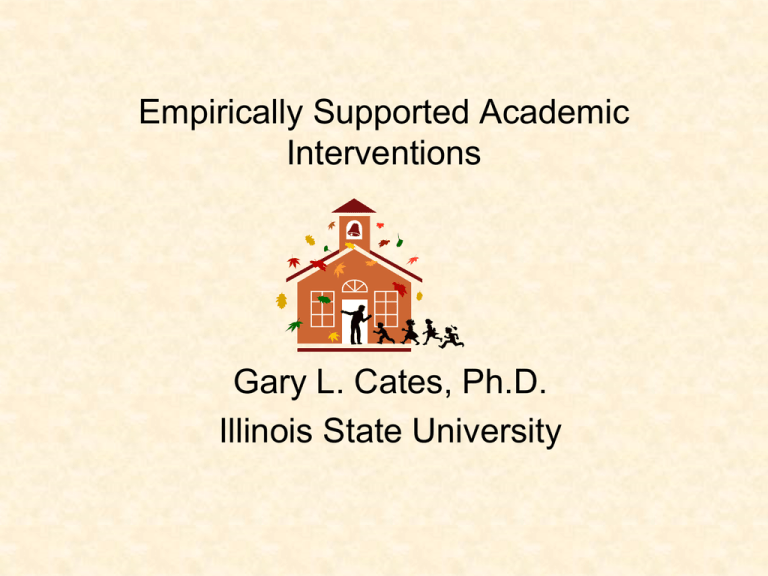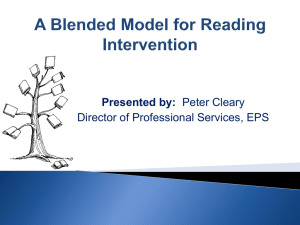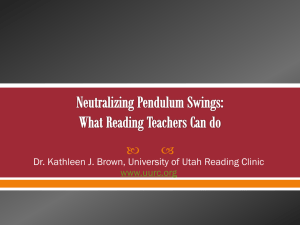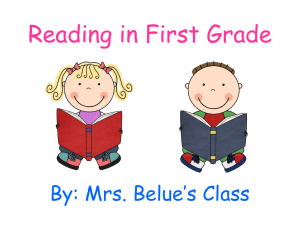Improving Outcomes for ALL Students Through
advertisement

Empirically Supported Academic Interventions Gary L. Cates, Ph.D. Illinois State University What are Scientifically Based Interventions? • Employs systematic, empirical methods • Ensures that studies and methods are presented in sufficient detail and clarity • Obtains acceptance by a peer-reviewed journal or approval by a panel of independent experts through scientific review • Uses research designs and methods appropriate to the research question Evidence-Based Interventions • School-based professionals have a responsibility for both promoting and implementing interventions that are evidencebased • AND objectively evaluating the effectiveness of those interventions through the data-based decision-making process. (NCLB & IDEA 2004) Research-Based or Evidence-Based Interventions • Are based on efficacy studies • Are scientifically rigorous meaning• -random assignment to all treatment groups • -carefully selected and well defined participant populations • -very highly trained implementers who have supervision. …Scientifically Rigorous • -Clearly defined independent variable(s); i.e., intervention(s) • -Clearly defined dependent variabledata • -A set of procedures to clearly implement the independent variable • Procedures for accurately measuring the dependent variable Be Good Consumers • Does the intervention meet the standards for Research-Based Interventions (internal validity)? • Has the published research been peerreviewed? • Have the results been replicated? • Does this apply to my population (External Validity)? Selecting Research-Based Strategies • Maalox Approach -attempt highprobability strategies that have demonstrated research support and are likely to show quick and effective results before conducting lengthy evaluations that may not lead to beneficial interventions. Standard Treatment Protocol • This models utilizes a set of standard research-based interventions implemented in tiers • They occur in a natural progression and are similar for students experiencing similar learning difficulties • The STP model can save time and energy • School/districts can inventory resources, programming, strategies, personnel etc. and sequence or prioritize their use USEFUL WEBSITES • www.fsds.org (Flexible Services Delivery System) • www.aimsweb.com (Aimsweb) • www.fcrr.org (Florida Center for Reading Research) • http://reading.uoregon.edu/ (Big Ideas in Reading) • http://pals.virginia.edu/Virginia/Activities/ (Un. of Virginia – PALS page – instructional strategies:) • http://www.interventioncentral.org/ (Intervention Central) • http://www.whatworks.ed.gov/ (What Works Clearinghouse) • www.centeroninstruction.org (Center on Instruction) Useful Websites • More detailed descriptions of interventions in areas of handwriting, math, phonemic awareness, phonics interventions, reading vocab, reading comprehension, reading fluency, spelling interventions, and writing interventions posted on:http://dev.lilt.ilstu.edu/csss2006/solutions/i ndex.html. Developed by Peggy Swerdlik fro Peoria (CSSS Project). • www.specialconnections.ku.edu • http://iris.peabody.vanderbilt.edu • www.campbellcollaboration.org Center on Instruction www.centeroninstruction.org • “Your gateway to a cutting-edge collection of scientifically based research and information on K-12 instruction in reading, math, science, special education, and English Language Learning. Explore links to topic-based materials, syntheses of recent research, and exemplars of best practices.” Center on Instruction www.centeroninstruction.org • • • • Reading-34 Reading Block (90) A Principal’s Guide Reading Research and Classroom Implementation • Data Driven Centers • Selecting Reading Programs, FCRR Center on Instruction www.centeroninstruction.org • Differentiated Reading Instruction • Planning, Scheduling, and Supporting Intensive Interventions for Struggling Readers • Put Reading First (NRP) • Reading Fluency Intervention • Reading Comprehension Strategies • Vocabulary Development What Works Clearinghouse www.w-w-c.org • What Works Clearinghouse (WWC) collects, screens, and identifies studies of effectiveness of educational interventions, programs, products, practices and policies. • Intervention rating-strength of evidence • Improvement Index-effect size • Beginning Reading What Works Clearinghouse www.w-w-c.org • • • • • Elementary Math Middle School Math English Language Learners Dropout Prevention Character Education The Campbell Collaboration www.campbellcollaboration.org • Systematic reviews of research evidence prepared and maintained by contributors to the Campbell Collaboration’s Review Groups are designed to meet the needs of those with a strong interest in high quality evidence on “what works” for educators and their students. The Campbell Collaboration www.campbellcollaboration.org • • • • • • After School Programs Class size and academic achievement Volunteer tutoring programs Parental Involvement Peer Assisted Learning Student Assistance Programs Intervention Central www.interventioncentral.org • Intervention Central offers free tools and resources to help school staff and parents to promote positive classroom behaviors and foster effective learning for all children and youth. The site was created by Jim Wright, a school psychologist and school administrator from Central New York Intervention Central www.interventioncentral.org • • • • • • • • • • • Intervention Ideas Tools for Educators CBM Warehouse RtI-Wire Downloads Movies On-Line Tools Worksheet Generator Behavior Reports List Builders Survey Generators CBM and RtI Resources Chart Wizard Special Connections www.specialconnections.ku.edu • Connects teachers to strategies that help students successfully access the general education curriculum • Instruction • Assessment • Behavior Plans • Collaboration • Direct Instruction Special Connections www.specialconnections.ku.edu • • • • • • • Cognitive Strategies Classroom Peer Tutoring Reading Acquisition Reading Comprehension Writing FBA PBIS The Iris Center http://iris.peabody.vanderbilt.edu • All Iris materials are feely available for use via the website and may be reprinted without permission • Star Legacy Modules • Case Studies • Activities • Information Briefs • Differentiated Instruction The Iris Center http://iris.peabody.vanderbilt.edu • • • • • • • Behavior Accommodations Collaboration Disabilities Diversity IDEA Transition Research Supported Behavioral Interventions Across a Three Tier Model of Support Things to keep in mind about interventions… Intensive and focused – it should give struggling readers a chance to practice a limited set of skills with immediate corrective feedback. Intervention is in addition to core reading program! Intervention starts at the lowest skill that is deficient then moves up the continuum as children reach automaticity and mastery Example: Focus on student’s proficiency with recognizing and expressing initial sounds before teaching segmentation of all sounds in words UNIVERSAL TIER 1: Benchmark/Core Programs (Elem): 1. Rigby Literacy (Harcourt Rigby Education, 2000) 2. Trophies (Harcourt School Publishers, 2003)* 3. The Nation’s Choice (Houghton Mifflin, 2003) 4. Macmillan/McGraw-Hill Reading (2003) 5. Open Court (SRA/McGraw-Hill, 2002)* 6. Reading Mastery Plus (SRA/ McGraw-Hill, 2002) 7. Scott Foresman Reading (2004) 8. Success For All (1998-2003) 9. Wright Group Literacy (2002) 10. Read Well* Reviewed by: Oregon Reading First and FCRR Comprehensive: Addressed all 5 areas and included at least grades K-3 ~5% ~15% ~80% of Students Peer-Assisted Learning Strategies (PALS): A Multiple Strategy Intervention <http://kc.vanderbilt.edu/pals/> PALS Research • Based on Juniper Gardens ClassWide Peer Tutoring Model • Has over 10 years of experimental research • Used in Title 1 and Non-Title 1 Schools • Implemented in urban and suburban schools • Includes high, average and low achievers as well as students with disabilities • Available in reading and math Critical Features of PALS • Supplemental reading practice several times per week (30-45 minutes each session, depending on grade level and activities) • Structured activities • Reciprocal roles (Coaches and Readers) • Individualized support-corrective feedback • More time on task with active engagement • Inclusion of all students with built-in opportunities for success • Facilitation of positive peer interactions • Opportunities to monitor student progress • Practical and Effective Strategies General Procedures for PALS • PALS is conducted three times each week (about 30-45 min. per session) but four times is recommended in Title 1 schools or very low achieving schools • Students are rank ordered , split in half, and strong readers in top half are paired with weaker readers in bottom half • Each pair is assigned to one of two teams • Teams and pairs remain together for 3-4 week, and partners work to earn points for their time each week • Within pairs, the stronger reader read first to provide a model, but coach and reader roles are switched during each activity • Partners read text at the level of the weaker reader. • Teachers monitor students, provide help, and award bonus points for good tutoring behaviors. PALS Activities for Kindergarten and FirstGrade Students-Includes Teacher-Led Practice and Partner Activities Conducted in Pairs • Phonological Awareness (e.g., saying first and last sounds, rhyming, counting sounds, segmenting, and blending) • Letter-Sound Correspondences (e.g., letters and letter combinations) • Decoding (e.g., words and sentences) • Fluency (e.g., sight words, stories, and book reading) PALS in Grades 2-6 • Partner Reading (11-12 minutes) -Stronger reader reads for 5 minutes -Weaker reader rereads the same text for 5 minutes -Weaker reader retells selection for 1 min. grades 2-3 and for 2 min. in grades 4-6 • Paragraph Shrinking (10 minutes) -Stronger reader reads new text, stopping to summarize after each paragraph; states the most important who or what, tells what mainly happened, and gives main idea statement in 10 words or less (5 min) -Weaker reader continues with new text using same procedure (5 min) PALS in Grades 2-6 (Continued) • Prediction Relay (10 minutes) -Stronger reader makes prediction for next half page, reads half-page, stops to verify prediction for 5 minutes -Weaker reader continues with new text using the same strategy for 5 minutes Error Correction in PALS • Reading aloud -Stop, You missed this word. Can you figure it out? Read the sentence again. -Reader waits longer than 4 seconds.) The word is ____. What word? Good! Read the sentence again. • Paragraph Shrinking -That’s not quite right. Skim the paragraph and try again. (Decide-correct, give points. Incorrect, tell the answer • Practice -Stories-Goldilocks and Little Red Riding Hood -Prompt card UNIVERSAL TIER 1 ( Middle and High School) Building Continuously Improving General Education Instruction ~5% ~15% Use of Teaching Routines and Learning Strategies(Kansas) Well Designed Curriculum with “Big Idea” Focus Effective Secondary Classroom Management Study and Organizational Skills ~80% of Students Curriculum Modification ~5% ~15% TIER 2 TARGETED: Strategic/Supplemental (Elementary): 1. Early (Soar to) Success (Houghton Mifflin) 2. Reading Mastery (SRA) 3. 6 Minute Solutions-F 4. Great Leaps (Diamuid, Inc.)*PA,P, F, 5. REWARDS (Sopris West)*P, F 6 Ladders to Literacy (Brookes) 7. Read Naturally *-F 8. Peer Assisted Learning Strategies: KPALS (PA, P) and PALS*-, F Earobics* (Tier III too)-PA 9. Project READ* (Tier III too) ~80% of Students ~5% ~15% TIER 2 TARGETED: Strategic/Supplemental (Middle School): 1. Early (Soar to) Success (Houghton Mifflin) 2. Reading Mastery (SRA) 3. Early Reading Intervention (Scott Foresman) 4. Great Leaps (Diamuid, Inc.)*-P 5. REWARDS (Sopris West)*-P 6 Ladders to Literacy (Brookes) 7. Read Naturally *-F 8. Peer Assisted Learning Strategies (PALS)*-F ~80% of Students ~5% TIER 2 TARGETED: Strategic/Supplemental (High School): ~15% Consultation Support ~80% of Students TIER 3: INTENSIVE Intervention (Elementary) ~5% 1. Corrective Reading (SRA)* ~15% 2. 3. 4. 5. 6. 7. 8. 9. 10. ~80% of Students Language! (Sopris West) Wilson Reading System* (Tier 2 also) Reading Mastery Earobics (phonics/phonemic awareness; Cognitive Concepts) Great Leaps/ Read Naturally (Fluency) (Tier II also) REWARDS (Fluency, Comp. and Vocab. in Plus Program) Soar to Success (comp.) Wilson Reading Program* Lindamood Phonemic Sequencing Reading Curriculum* ~5% ~15% ~80% of Students TIER 3: INTENSIVE Intervention (Middle School and High School) 1. Corrective Reading (SRA)* 2. Failure Free Reading* Language! (Sopris West) 3. Wilson Reading System* 4. Reading Mastery 5. Earobics (phonics/phonemic awareness; Cognitive Concepts) 6. Great Leaps/ Read Naturally (Fluency) 7. REWARDS (Fluency, Comp. and Vocab. in Plus Program) 8. Soar to Success (comp.) 9. Lindamood-Bell Programs* (Phonics) 10. Spell-Read P.A.T* Early Literacy Interventions • Letter or sound bingo • I say you say (Blend/Segment) – Deletion – Substitution Letter Name AcquisitionDiscrete Trial Learning • Give the student an unknown letter-name probe. • Two Known letter cards and 1 unknown letter cards are placed in front of the student • Tell the student to point to the unknown card. • A) If the correct letter is named, the cards are mixed and placed in front of the student who is asked to point to the unknown letter again. When the student is able to correctly point to the unknown letter five times the letter becomes known. Letter Name Acquisition-Discrete Trial Learning • Then, one of the original known cards is removed leaving the new known card and the old known card . Finally a new unknown card is added to the grouping. B) If an incorrect letter is named, the student is told the correct name and asked to repeat the correct letter name. Then the cards are mixed and placed in the front of the student again. The examiner asks the student to point to the unknown letter. • Steps 2 & 3 are repeated until all of the unknown cards are considered known Letter Naming-Listening Passage Preview • Place the Letter naming probe in front of the student. • Explain that the examiner will read the probe to them before the student is allowed to read it to them. May need to point to each letter as they read the probe in order to keep the student’s attention • Read the probe correctly • Allow the student to read the probe and note any errors. • Repeat with different probes as often as desired. Phonics • Systematic and Explicit Phonics • Instruction significantly improves young children’s decoding, spelling, and reading comprehension and older students’ word reading and oral text reading skills. -Systematic: logical sequence and careful selection of letter-sounds for instruction -Explicit: precise directions for teachers or careful wording to emphasize accurate models for students and to make letter-sound relationships and conspicuous Why is Phonics Instruction So Challenging for Many Teachers? • Many teacher preparation programs do not provide training in phonics instruction • The English alphabet contains 26 letters but we use roughly 44 phonemes. These sounds are represented by as many as 250 different spellings (e.g., /f/ as in ph, f, gh, ff) • Many core beginning reading programs have not emphasized systematic and explicit phonics instruction Phonics Instruction • Use a functional sequence of lettersounds , one that leads to rapid success in reading words. • Provide opportunities for practicing decoding skills both in word lists and in connected text. Systematic and Explicit Phonics Instruction • Introduce most common sound for a new letter /k/ for “C” • Separate instruction of potentially confusing letters due to visual or auditory similarity h/n, b/d) • May introduce lower case letters first (more functional) • Start with high-utility letters (s,t, m, and vowels, not z, x) Systematic and Explicit Phonics Instruction(Cont.) • Select words that start with continuous sounds rather than stop sounds when beginning to sound out words-or for blending to sound and segmenting practice (use “mat” before “bat”) • Potential sequence for introducing letters <a,m, t, s, S, i, f, d, r, o, O, g, l, h, u, U, c, C, b,n, k, K, v, V, e, w,W, j, p, P, y, Y, T, L, M, F, D, I, N, A, R, E, H, G, B, x,X, q, z, Z, J, Q> Fluency • Repeated and monitored oral reading significantly improves reading fluency and overall reading achievement • Caution: Silent, independent reading with little guidance or feedback may not be enough to improve fluency and overall reading achievement Why Fluency is Important • More fluent readers focus their attention on making connections among the ideas in a text and between these ideas and their background knowledge. Therefore, they are able to focus on comprehension • Less fluent readers focus their attention primarily on decoding and accessing meaning of individual words. Therefore, they appear to have little attention left for comprehending connected text Reading Fluency Interventions • • • • • • Repeated Readings Performance feedback Contingent Reinforcement Listening While Reading Choral Reading Paired Reading/Duet Reading Fluency Interventions • Model fluent reading. Have students reread text themselves. Read aloud daily. • Students should read aloud repeatedly with guidance. • Use text at independent level (approx 95% accuracy) • Use adults, peers, or tape recorders for modeling and practicing one to one (although can do class wide partner reading). Choral reading may engage groups of students. Error Correction Procedures • • • • Sentence Repeat Error Drill Phrase Drill Word Supply Research Based InterventionsReading Fluency-Newscaster Reading • Objective: To increase prosody (expression) for students who have difficulty with phrasing and expression • Materials: Short texts at the student’s instructional level (can read with at least 95% accuracy) Research Based Interventions-SelfMonitoring-Pencil Tap • Objective: To increase self-monitoring and self-correction of errors in reading among students who read with low accuracy. • Materials: Short texts at the student’s instructional level Vocabulary • Many words are learned indirectly through everyday experiences with oral and written language (e.g., conversations, listening to others read, reading independently). • However, some vocabulary words must be taught directly through specific word instruction or through word-learning strategies Direct Vocabulary Learning: Specific Word Instruction • Direct vocabulary instruction aids in comprehension • However, a text may have too many unknown words for direct instruction-be selective with vocabulary. Students do not have to know all words in order to understand text. • Words selected should be important, useful, and difficult. • Teach specific words prior to reading text (e.g., use a model, synonym, or definition) • Repeat exposure to vocabulary often and in many different contexts • Teach word-learning strategies (use of dictionaries and other reference tools, contextual clues, word parts) Direct Vocabulary Learning: Specific Word Instruction (Cont.) • An important aspect of teaching vocabulary is selecting a set of appropriate examples Examples for Specific Word Instruction • Model the concept “above”. Use hand or object and place above or not above other objects (demonstrate position). • Teach meaning or “gigantic” by using the known synonym “large”. Connect to prior knowledge, check with examples and nonexamples, and use in sentences • Teach meaning by providing definition”: “exita door that leads out of the building. Is this (point to front door) an exit or not? How do you know? Comprehension • IS the reason for reading • Comprehension is both purposeful and active. Good readers have a purpose for reading, and they think actively about what they are reading as they are doing it (metacognition-monitoring understanding during reading and applying “fix up” strategies, such as adjusting reading speed and rereading; also checking understanding afterward). Comprehension Interventions • • • • • TELLS Pre-Teach Vocabulary Pre-Teach Concepts Timelines & Flow Charts Summarization Comprehension Interv. Cont. • SQ3R (Study, Question Read, Recite, Restate) • POSSE (Predict, Organize, Search, Summarize, Evaluate) • Click or Clunk Effective Comprehension Strategies • Comprehension Monitoring-involves students using a set of steps to recognize when they have difficulty understanding • Graphic and semantic organizers (webs, charts, frames)-to illustrate relationships among ideas and events • Summarizing-involves synthesis of important idea; helps to identify main ideas, eliminate unnecessary information, and remember content • Answering questions and generating own questionshelps students to establish purpose, focus, attention, think, and monitor actively, review content, and relate content to prior knowledge. Comprehension-Text Lookback • Text lookback is a strategy that students can use to boost their recall of expository prose by looking back in the text for important information. • Student write lookback questions for assigned readings. • Must teach skimming to be effective Comprehension Strategies Should Be Taught Directly • As with other “big ideas” in reading instruction, comprehension strategies must be taught explicitly -Provide explanations--why strategy helps and when it should be applied -Model or demonstrate strategy-think aloud -Provide guided practice using strategy -Scaffold assistance during practice opportunities until students become independent in applying strategy Comprehension: Click or Clunk • When the student reaches the end of each paragraph, they should ask themselves what did the paragraph say. If they understand, they say, “Click:” If not,they say, “clunk” and they do not continue reading and refer to their reading checklist. • When the student reaches the end of a page, they ask themselves “What do I remember”? If they remember they say, “click”. If they do not remember, they say “clunk” and refer to the study sheet. Reading Comprehension-Mental Imagery: Improving Text Recall • By constructing “mental pictures” of what they are reading and closely studying text illustrations, students increase they reading comprehension • In teaching, read aloud and ask class what mental pictures come to mind as they read • Independently students are reminded to “make a picture in your head about what you are reading and study the pictures carefully”. Questions?








